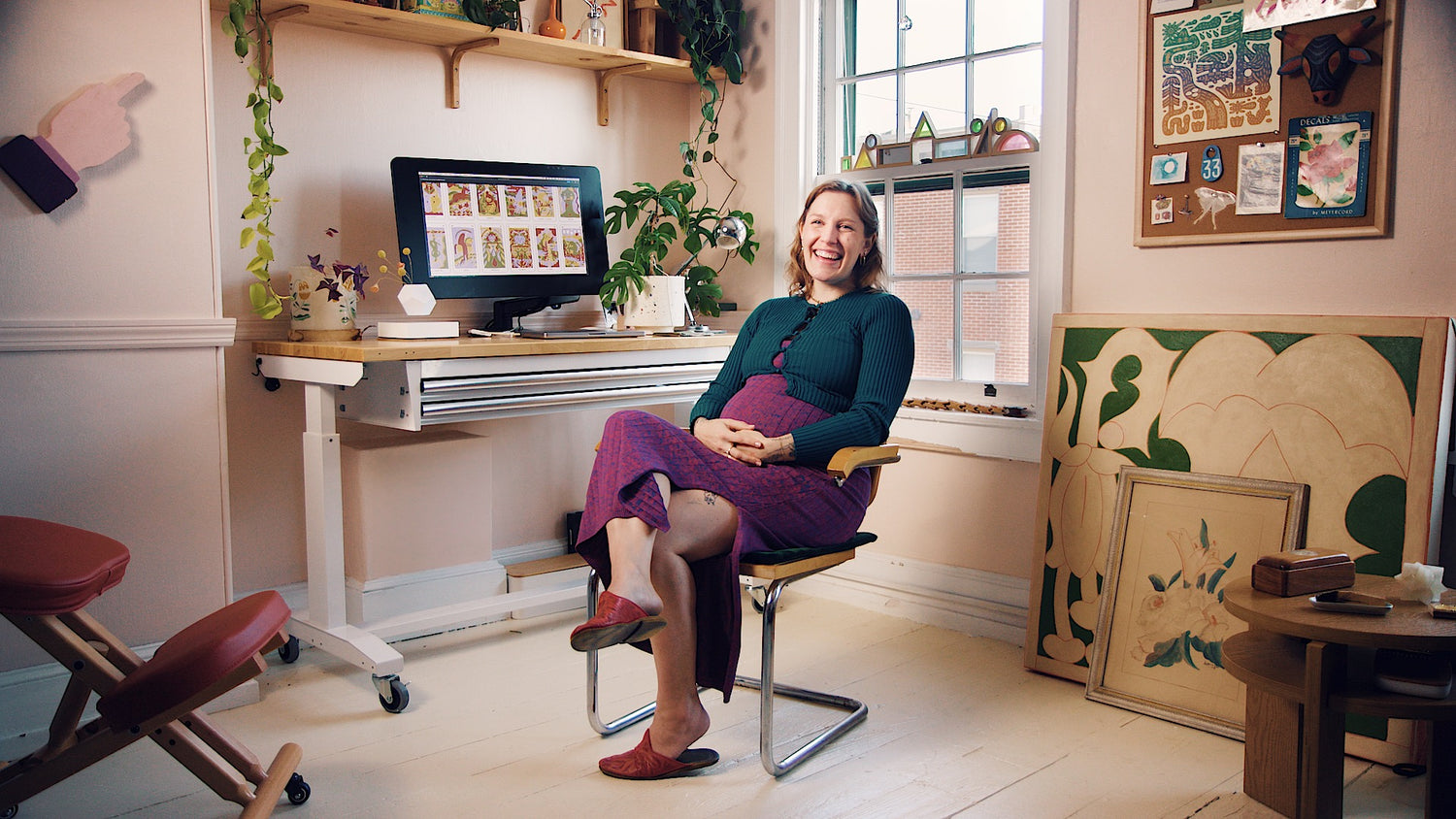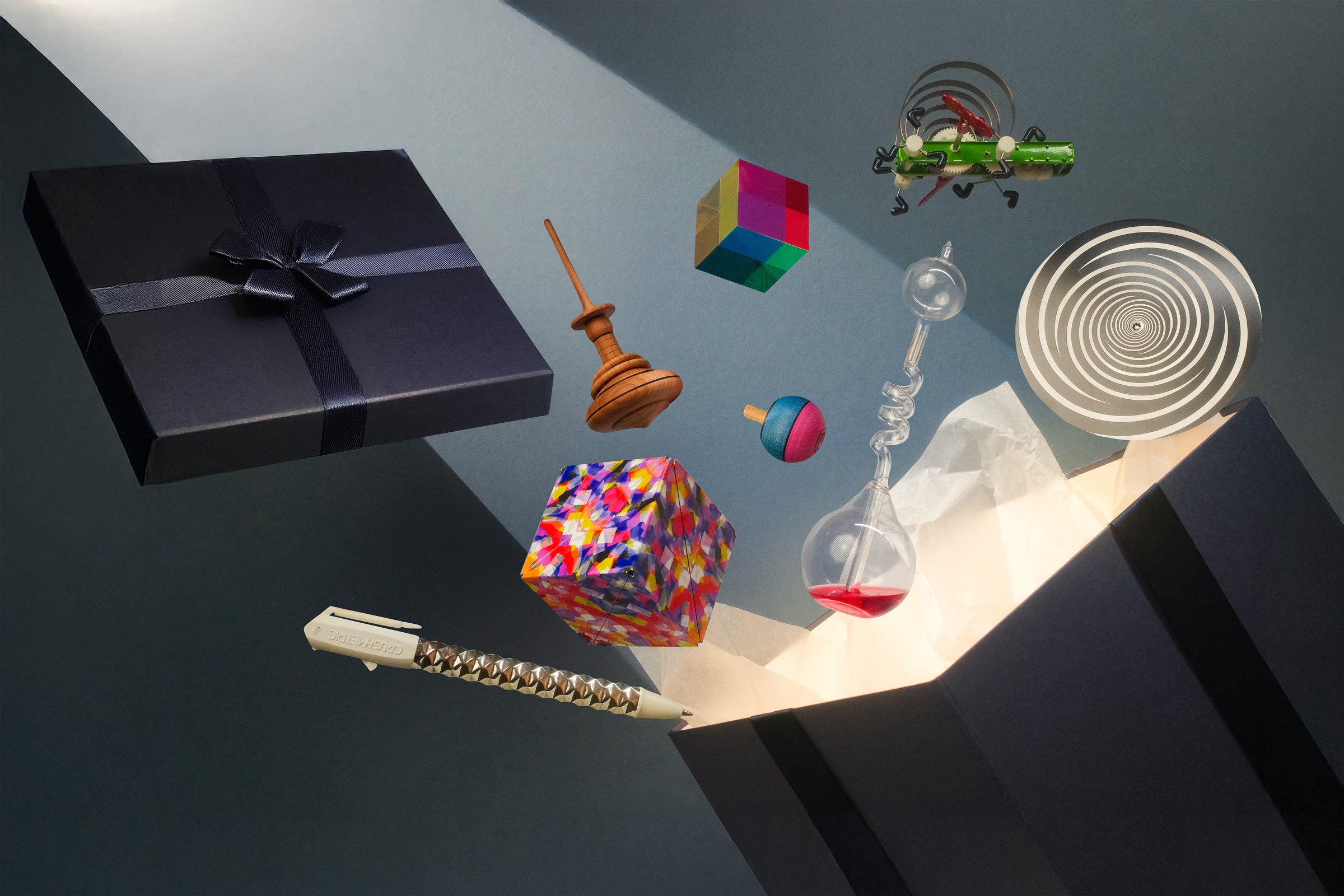“My life is a series of very definite and absolute decisions,” says Kelly Thorn, a mutli-disciplinary artist based in Philadelphia. Though her choices have been singular, her interests are varied. Her areas of expertise include graphic art and design, hand-poked tattoos, lettering, and illustration. Oh, and most recently, painting. “I am hoping that I never stop finding new hobbies because it is like the spice of my life.”
Her first project with Art of Play evolved from an unrealized commission from a speakeasy magic club in Chicago. That custom deck fell through, but the 1920s-inspired tuck box she’d designed remained. She jumped at the opportunity to build out the project, which became Lady Moon. “I came up with this idea because the original deck had a lady on it and she’s holding an orb, because that looks Art Deco. So there’s no concept within that, but I was like, What if the orb is the moon?” And everything else grew from there.

When she had the chance to pitch another idea, she didn’t hesitate.
A tarot deck was something she’d been wanting to create for a while, but hadn’t had a reason to. One thing Kelly has realized since taking up painting is that abstract work does not come naturally to her. But in the specificity of the tarot deck, where “it’s all representational work, but there are abstract qualities to it,” something clicked. “That kind of like merged art and design for me, so it was weirdly therapeutic,” says Kelly. The world-building aspect of the Tarot of Oxalia deck drew her in. “I had to keep pulling myself back,” she says, “like nobody’s gonna read this, you don’t need to make a whole galaxy”—she pauses for a moment—“but I did.”

Art of Play sat down with Kelly Thorn to learn about the inspirations behind the Tarot of Oxalia, currently on Kickstarter. This interview has been edited for length and clarity.
Art of Play: What is your experience with tarot?
Kelly Thorn: I think I started reading tarot in early 2019. I picked it up very casually and realized there’s so much to learn because there’s, you know, a ton of cards. Each card has a different meaning, and there are different spreads that you can read. If you pull a card out that’s reversed–that has a different meaning!
So, I picked it up casually, was immediately intimidated but also very excited to learn. As I’ve practiced more for myself, I discovered the best way to read tarot was to do it intuitively.
I typically use it as a form of therapy. I find that something like journaling is a super helpful practice for my everyday life. It helps me get what’s inside me on the outside. When I look at tarot on the table, it helps me hone in on what I’m actually feeling. Because if you’re having a really good day and you pull out the Death card, what does that mean?
You get into what is underneath the surface instead of what’s just going on in your life. You can use tarot as a tool for introspection.
Tell us about the Tarot of Oxalia.
Art of Play has just been cheering me on from every angle to create a tarot deck born out of science fiction. Tarot already has a story to the entire deck from start to finish. So I layered my own story on top of it. The Tarot of Oxalia is sort of about the universe of Oxalia. It’s a little bit science fiction, a little bit Greek mythology.
For new tarot users, each of the suits of the minor arcana have a corresponding element. Cups, water … swords are air, wands are fire, and coins are earth. They all have their own elemental correspondences. And so I created these planetary bodies that all exist within the universe of Oxalia. I wrote poems for each of the planets, inspired by writers like Octavia Butler and Ursula Le Guin, as well as some occult mystics from the 20th century.
“The spirit of nature voluntarily binds its power.”
Hilma af Klint is another big artist that inspired me. She was a mystic and an incredible abstract painter that was way ahead of her time. She would be inspired by other spirits to create her work. Sometimes, she became possessed and sketched out compositions.
I actually start the booklet out with a quote by Klint: “The spirit of nature voluntarily binds its power.”
Walk us through a bit of the design process behind this tarot deck.
It was really important to me to base the Tarot of Oxalia deck off of the Rider Waite Tarot deck, and I took liberties with each card … how the characters are built, what their eyes do, what their mouths do, the stylization of each of the characters. The Death card, for instance, was particularly heinous to make. I don’t know why. It was the only one that I had more than two finished versions of and I just hated it. I trashed it every time, which is really interesting because it’s the Death card. It’s fitting.

And then we have the amber and opal editions of the tarot deck. The amber deck is one that is more in tune with grounding, and has a more tangible feel to it. It’s warmer. Richer.
For the opal edition, we wanted it to feel more ethereal, like it came from outer space. So, it was really important that the colors work and correspond to that. The colors on the opal deck, with the holographic foil, are directly inspired by the sun, or turning crystals and prisms, so it all feels otherworldly.
When you’re doing a reading, are there any cards that particularly delight you when you pull one out?
I love the Empress. I love the Star, which, in this version, has seven toes. I did that partly because I wanted her to feel more alien.

And then the Fool is my all-time personal favorite! The Fool encapsulates the way that I live … very happy-go-lucky and not always looking at the ground … like she’s about to walk off of a cliff!
How do you want people to use this deck?
So, a way that I would love for people to use this deck is in a very personal, everyday, sort of ritualistic way. I think tarot can be a really intimidating practice to take on. But I would love it if there was a deck where people weren’t as intimidated by the number of cards or their meanings.
Instead, you could use it as an opportunity to listen to yourself. Use it as an opportunity to look inward and find out what is important to you.
I’m open to listening to myself rather than listening to what a book is telling me a card means. When you do that, it really opens up a lot of doors. It gives me the opportunity to listen to myself, and ask: What is important to me on any given day? How can I focus on what is important to me in my life?
Tarot lets me figure out what my core pillars are. I think any practice that you can give to yourself in the purpose and pursuit of self-discovery is so important.
Written by Rachel del Valle and Art of Play





Leave a comment
This site is protected by hCaptcha and the hCaptcha Privacy Policy and Terms of Service apply.